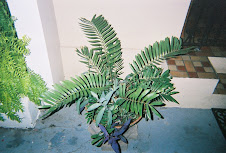the Hibiscus and Polyscias. There are two
varieties of the first and three of the second, now planted in the south garden. The hibiscus will provide nectar for bees, hummingbirds and Spindalis, both will offer shade, quiet and lots of privacy. The Polyscias can grow up to twenty feed. There are 114 species of them. Not found in nurseries down here, I recommend them for their vertical growth and problem free maintenance.
BOTANICAL NAMES TELL TALES
TAKEN FROM fine Gardening
August 1999
by Dr. Susan Verhoek
TAKEN FROM fine Gardening
August 1999
by Dr. Susan Verhoek
Latin plant names are usually chosen by botanists because of some connection with the plant. Botanical names such as Claytonia virginica, Viola missouriensis,
Pieris japonica, Linnacea borealis, and Aquilegia alpina reveal where these plants originally grew in the wild. For example, Linnaea borealis--borealis meaning northern in Latin--grows as far north as USDA Hardines Zone 2.
Some latin names signify bloom times. In Latin, vernalis means spring, so Hamamelis vernalis would be a good witch hazel for spring bloom. Adonis aestivalis, which is commonly known as summer adonis, provides good summer
color, while Colchicum autumnale brightens the garden in fall, and Eranthis hyemalis produces its bright yellow flowers in late winter.
Many names are descriptive and are based on the same Latin words that provides
adjectives in English. Rosa multiflora has multiple flowers, just as Clintonia uniflora has one. Leaf shape is also an obvious source for names. Zelkova serrata has leaf edges with small teeth. The edges of the leaves of Yucca filamentosa come apart as curling threads. Oak trees belong to the genus Quercus, so the oak leaf hydrangea is aptly named Hydrangea quercifolia.
Other names reveal useful economic aspects of a plant. Cultivated plants are frequently sativus, while edible plants are edulis. You could wash your clothes
or hair with any plant named saponifera, but beware of the ones called somniferum, as they will put you to sleep.
Healing herbs are sometimes dubbed officinalis or officinarum. And while the leaves of Ilex paraguariensis are used to make tea in Paraguay, tea of Ilex vomitoria is probably best avoided. Even the reactions of botanists to certain plants become apparent. Consider the obviously frustrated botanists responsible for the spiny-leaved genus Damnacanthus or the species name exasperatus.
Pieris japonica, Linnacea borealis, and Aquilegia alpina reveal where these plants originally grew in the wild. For example, Linnaea borealis--borealis meaning northern in Latin--grows as far north as USDA Hardines Zone 2.
Some latin names signify bloom times. In Latin, vernalis means spring, so Hamamelis vernalis would be a good witch hazel for spring bloom. Adonis aestivalis, which is commonly known as summer adonis, provides good summer
color, while Colchicum autumnale brightens the garden in fall, and Eranthis hyemalis produces its bright yellow flowers in late winter.
Many names are descriptive and are based on the same Latin words that provides
adjectives in English. Rosa multiflora has multiple flowers, just as Clintonia uniflora has one. Leaf shape is also an obvious source for names. Zelkova serrata has leaf edges with small teeth. The edges of the leaves of Yucca filamentosa come apart as curling threads. Oak trees belong to the genus Quercus, so the oak leaf hydrangea is aptly named Hydrangea quercifolia.
Other names reveal useful economic aspects of a plant. Cultivated plants are frequently sativus, while edible plants are edulis. You could wash your clothes
or hair with any plant named saponifera, but beware of the ones called somniferum, as they will put you to sleep.
Healing herbs are sometimes dubbed officinalis or officinarum. And while the leaves of Ilex paraguariensis are used to make tea in Paraguay, tea of Ilex vomitoria is probably best avoided. Even the reactions of botanists to certain plants become apparent. Consider the obviously frustrated botanists responsible for the spiny-leaved genus Damnacanthus or the species name exasperatus.


















-25.jpg)
-24.jpg)




































-22.jpg)
-25.jpg)
-24.jpg)






-16.jpg)
-13.jpg)
-08.jpg)
















































